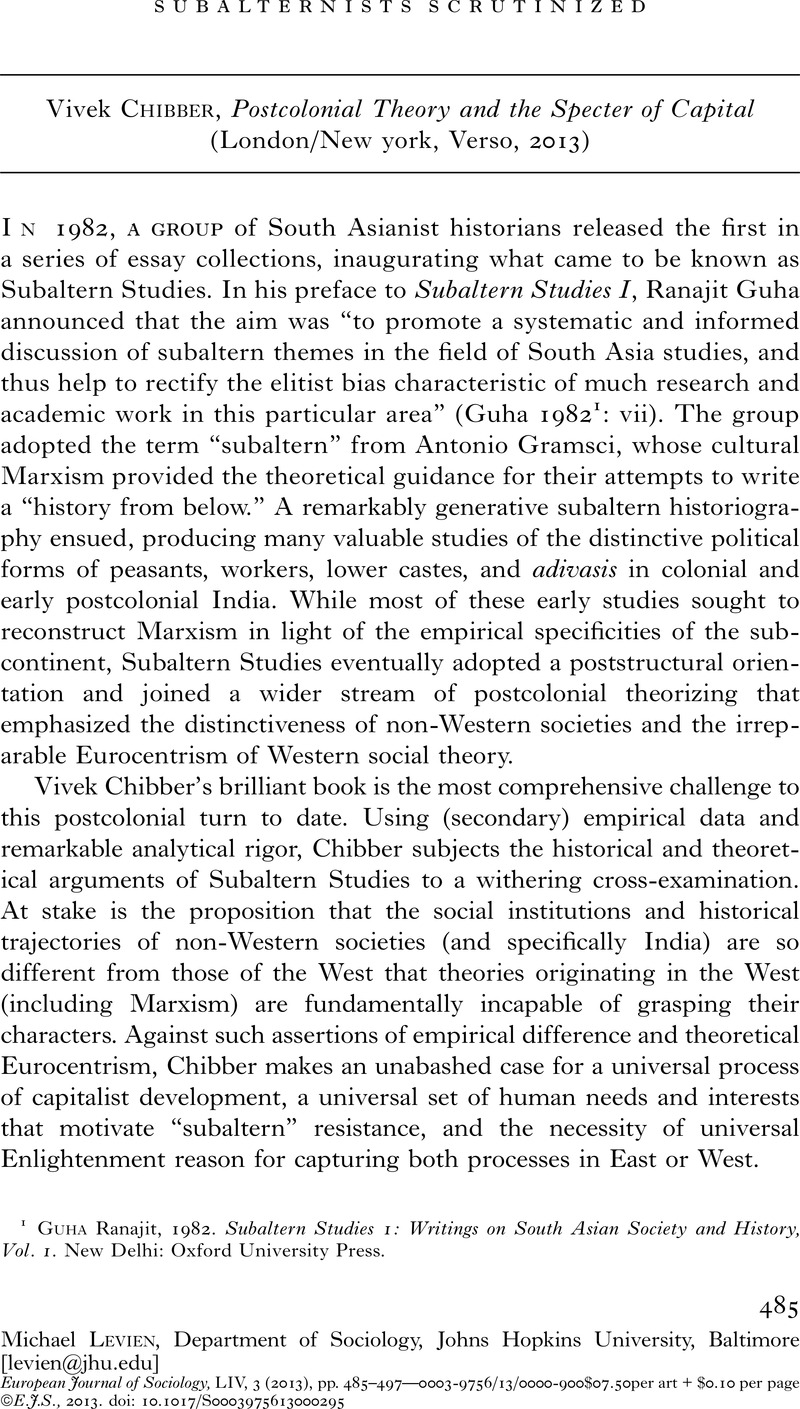Article contents
Subalternists Scrutinized - Vivek Chibber, Postcolonial Theory and the Specter of Capital (London/New york, Verso, 2013)
Published online by Cambridge University Press: 22 January 2014
Abstract

- Type
- Book Reviews
- Information
- European Journal of Sociology / Archives Européennes de Sociologie , Volume 54 , Issue 3 , December 2013 , pp. 485 - 497
- Copyright
- Copyright © A.E.S. 2013
References
1 Guha Ranajit, 1982. Subaltern Studies 1: Writings on South Asian Society and History, Vol. 1. New Delhi: Oxford University Press.
2 Guha Ranajit, 1997. Dominance Without Hegemony: History and Power in Colonial India. Cambridge: Harvard University Press.
3 Chatterjee Partha, 2013. “Subaltern Studies and Capital.” Economic and Political Weekly 48(37): 69-75.
4 Riley Dylan J. and Manali Desai, 2007. “The Passive Revolutionary Route to the Modern World: Italy and India in Comparative Perspective.” Comparative Studies in Society and History 49(4): 815-847.
5 Moore Barrington, 1966. Social Origins of Dictatorship and Democracy: Lord and Peasant in the Making of the Modern World. Boston: Beacon Press.
6 Chakrabarty Dipesh, 1989. Rethinking Working Class History: Bengal 1890-1940. Princeton: Princeton University Press.
7 Chakrabarty Dipesh, 2000. Provincializing Europe: Postcolonial Thought and Historical Difference. Princeton: Princeton University Press.
8 Sivaramakrishnan K., 1995. “Situating the Subaltern: History and Anthropology in the Subaltern Studies Project.” Journal of Historical Sociology 8(4): 395-492.
9 Ludden David, 2001. “Subalterns and Others in the Agrarian History of South Asia”, in SCOTT James C. and Nina BHATT (eds.), Agrarian Studies: Synthetic Work at the Cutting Edge, New Haven, Yale University Press.
10 Patnaik Utsa, 1976. “Class Differentiation Within the Peasantry: An Approach to Analysis of Indian Agriculture.” Economic and Political Weekly 11(39): A82-A101.
11 Bagchi Amiya Kumar, 1990. “Working Class Consciousness.” Economic and Political Weekly 25(30): PE54-PE60.
12 Chatterjee Partha, 1984. Bengal, 1920-1947: The Land Question. Calcutta: K.P. Bagchi.
13 Chatterjee Partha, 1986. “The Colonial State and Peasant Resistance in Bengal, 1920-1947.” Past and Present 110: 169-204.
14 Guha Ranajit, 1999. Elementary Aspects of Peasant Insurgency in Colonial India. Durham: Duke University Press.
15 Hobsbawm E.J., 1959. Primitive Rebels. New York: Norton.
16 Scott James, 1977. “Peasant Revolutions: A Dismal Science.” Comparative Politics 9(2): 231-248.
17 Lakatos Imre, 1978. The Methodology of Scientific Research Programs. Cambridge: Cambridge University Press.
18 Burawoy Michael, 1989. “Two Methods in Search of Science: Skocpol Versus Trotsky.” Theory and Society 18: 759-805.
- 3
- Cited by




